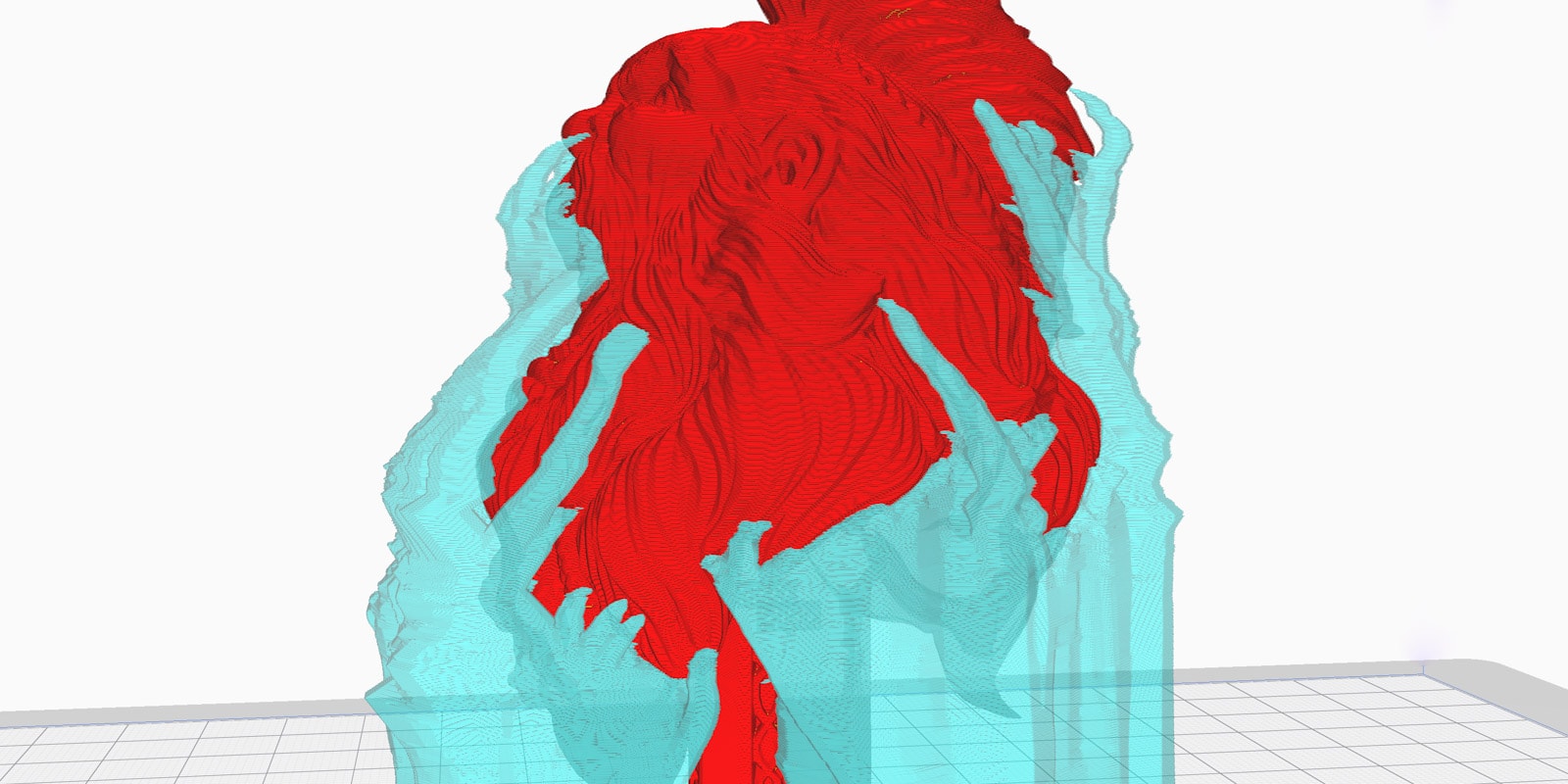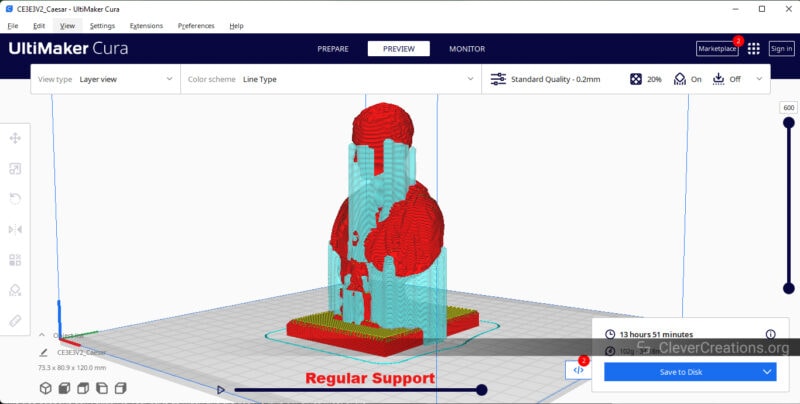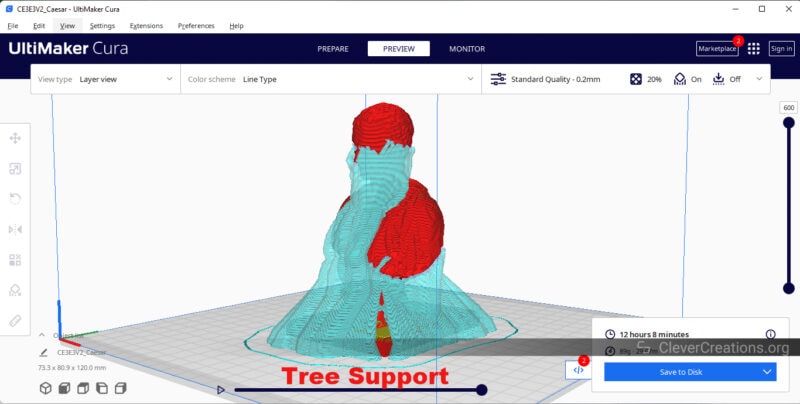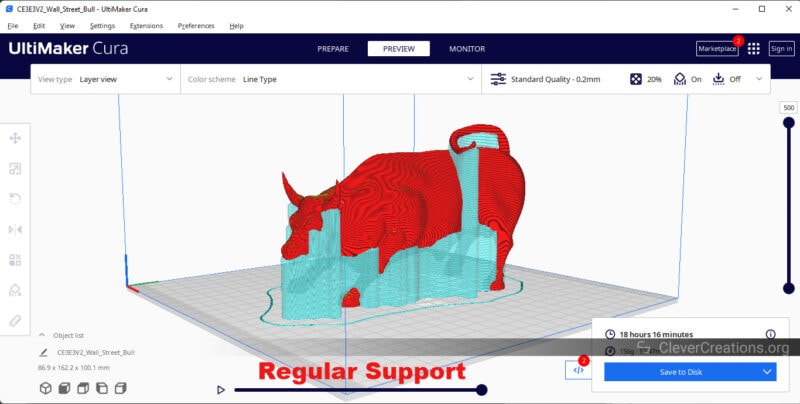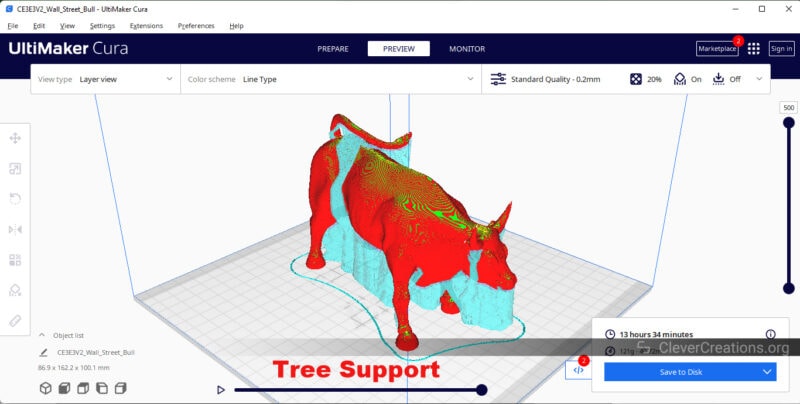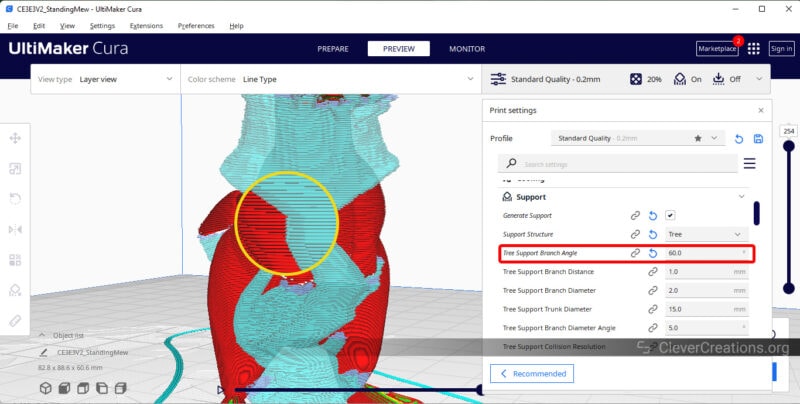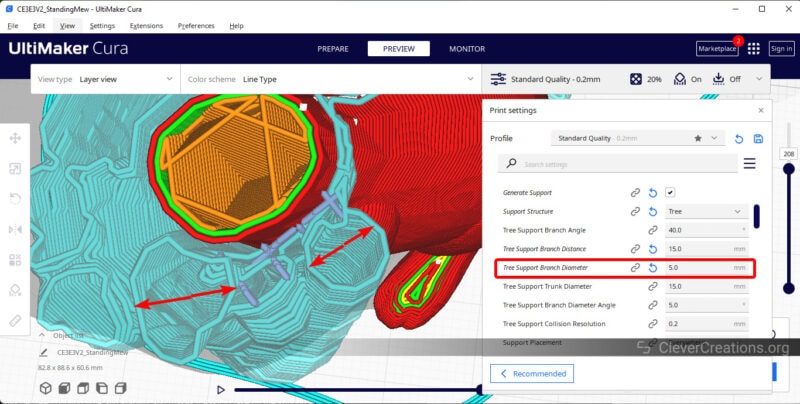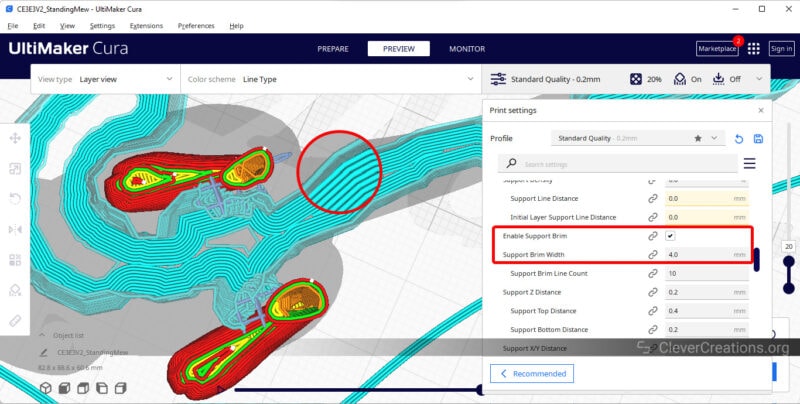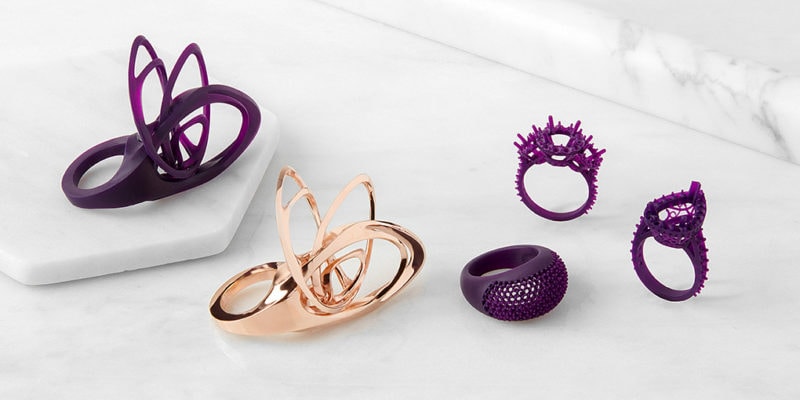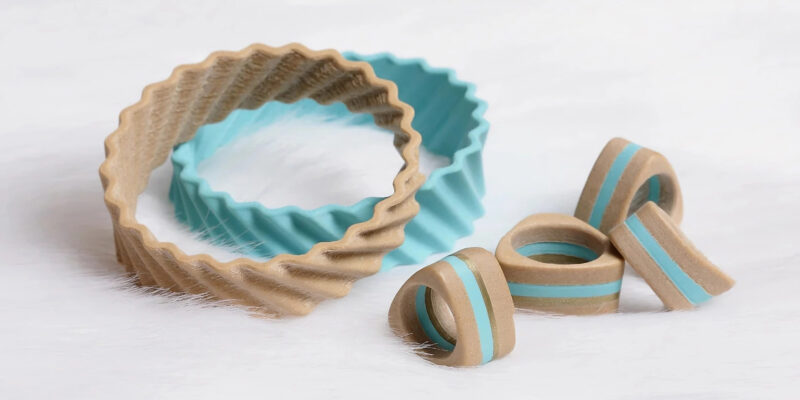Supports are weird! Often you want them in your 3D prints, but nobody really likes them. Standard support structures don’t always work well and are known for being hard to take off the model. You can always “fine-tune” your support settings, but let’s be honest: they often still don’t print the way you hoped for.
Enter tree supports in Cura! Tree supports are all the hype nowadays. Those who’ve used it often don’t go back to your normal support, and rightly so. Tree supports are fast, easy to remove, and look fantastic.
In this article, we’ll take a shovel to the ground and dig to the roots of Cura tree support. By the end, you’ll know exactly when to use them and which tree support settings to use.
Let’s get sappy and branch out into the world of tree supports!
Why Do You Need Support Material in 3D Printing?

Before discussing Cura tree supports, let’s talk about what support material is and why you want to use it in 3D printing. This will help you understand why tree supports are so good at what they are supposed to do.
A typical Fused Deposition Modeling 3D printer creates objects one layer at a time. It adds a layer on top of a base layer, and after hundreds of these “additions,” you have a fully 3D-printed part. That’s why 3D printing falls under additive manufacturing.
When 3D printing something like a cube, there is always a previous layer that supports the entire new layer. After all, each layer has the same shape and size.
But what if the 3D printer does not have a previous layer to stick its new material to? For example, let’s say you want to print a complex model, where each layer is significantly different from the one before it. In this case, the 3D printer needs something else to adhere its material onto and build upon.
This is where support materials come in. Support materials are usually made of the same material as your 3D-printed part and provide support while the 3D printer builds the part layer by layer. When configured correctly, they can be easily detached afterward.
In short, supports make it easy to print models that are complicated and have steep overhangs. These structures give you full freedom to create complicated models without having to worry about sagging or other quality issues related to unsupported 3D printing.
What are Tree Supports?
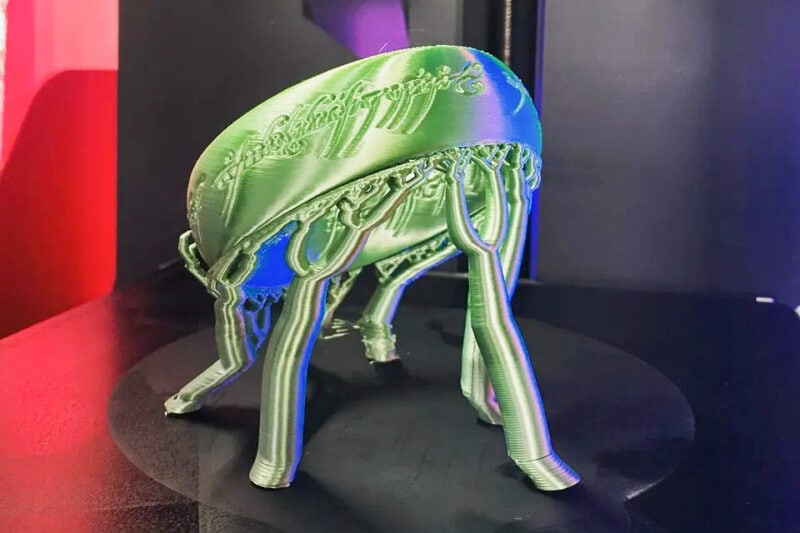
Tree supports are a type of support material specifically designed to provide the most efficient and robust support structure possible. As the name suggests, they look like trees: they have a “trunk” at the bottom with “branches” reaching out in multiple directions.
Tree supports were first added in the Cura 3.2.0 release in February 2018. First only available in the Cura Experimental section, they were officially added to Cura in 2020, in its 4.7.0 version.
During the printing process, the trunk provides strength, whereas the small branches support different parts of your 3D prints without strongly adhering to the model itself. That way, when it is time to remove the support material, it is easier for you to break off the branches without damaging your 3D print.
Since most of the stems and branches of tree support are hollow, you save a lot of time and printing material compared to a normal support structure. The result is lower printing costs, which is ideal if you are looking to make money with a 3D printer.
Cura tree supports are best suited for 3D printing miniatures, decorative pieces, statues, and other models with many overhangs. They support the overhang regions of your parts in the best possible way and leave little to no markings on the surface of your print.
Tree Support vs. Regular Supports
Tree support and regular support material both provide similar functionality, but there are a few key differences between the two.
Shape

Normal supports are just vertical structures that hold your 3D prints’ overhangs up. Depending on your print settings, you can alter the density and location of these vertical pillars.
The tree support structure in itself looks distinct. They look more like trees because of how they are made. It has a trunk and several small branches that reach out to the overhangs in your models.
The tree-like shape also makes it easy to take out the supports. With well-tuned tree support settings, the entire support structure can come off as a single piece, making it a great showpiece by itself.
Slicing Complexity
Slicer software has a pretty easy time with traditional supports. They’re simple vertical pillars, and the design is also relatively simpler than the tree structure. These require less calculation, and as a result, the slicing is quicker for regular support structures.
In contrast, tree supports involve lots of calculations. The slicer needs to find the best angles and paths for the many support branches. Computationally, this is significantly more difficult and takes more time.
The extra time you spend slicing your 3D model is often made up for during 3D printing because tree supports tend to be faster to print. All in all, the Cura tree support option gives you the better deal here.
Surface Quality
Regular supports stick to the part’s surface more than tree supports do. If your 3D prints have a lot of overhangs, support material will stick to the parts in places where it isn’t needed. This makes it hard to clean up afterward and negatively affects the quality of the models you 3D print.
Tree supports are made so that they don’t stick to things they don’t need to. You don’t get ugly surface marks, and it’s also easier to get rid of the support material after printing.
In the picture above, you can see how Cura’s regular and tree supports for the Caesar bust compare. The tree supports don’t touch the baseplate or any other part of the part except for the overhangs. But with traditional supports, the chin and nose need to be held up by support placement on the baseplate.
As a result, the print quality is significantly improved. If you are looking to sell 3D prints, this can give your products a big advantage over the competition.
Material and Time
We already covered it briefly in the previous sections, but tree supports are much more efficient when it comes to materials and time. Since most of the tree support structure is hollow, you save on printing material compared to regular supports.
The printer also doesn’t have to spend time printing unnecessary material, so you end up saving a lot of time as well. If you print giant models on a big 3D printer or many small ones at once, this difference adds up quickly.
In conclusion, Cura tree supports are the way to go if you want better surface quality, cost savings, and faster printing times. It’s a no-brainer!
When to Use Tree Support
Tree support is the best way to support items like the ones pictured above, as well as busts, cosplay masks, models, and figurines. Any 3D model that has lots of overhangs and small features.
Let’s take a look at the Wall Street Bull 3D print. If you print this bull with regular supports, its tail will need a support structure built on the body of the bull. The underbelly is also too big for regular support material. To support every part of the bull, it will need a lot of material and fine-tuning for good results.
Now compare it to a 3D print sliced with tree supports below. Nothing hits the body of the bull, and only a thin branch supports the tail. There are only a couple of small hollow trunks that are placed strategically for the underbelly. When you take the tree supports off, everything comes off in one piece, and the bull has practically no marks left on it.
That said, you should always check the shape of your model before deciding on using tree supports. In some cases, regular supports are still better.
Go for tree supports for busts, minis, and figurines. For models with large flat surfaces such as enclosures and casings, regular supports are still a good solution.
Recommended Cura Tree Support Settings
To access the Cura tree support setting, simply switch the Support Structure to Tree in the Support section. Make sure that the Settings visibility is set to all.
Next, enable the Generate Support option and select generate tree supports from the dropdown menu. Finally, you can adjust the tree support settings to your liking.
As of writing this article, this tree support system is not yet included in the latest release version of Cura. You will need to download the Alpha release to test the new tree supports.
Branch Angle
The Tree support branch angle controls how your branches are tilted in relation to your printer’s Z-axis. When they are at a lower angle, they are more vertically straight and stable. When set to a higher angle, they can reach your parts better.
By default, Cura sets it to 40 degrees, which works great for most models. If you want to try different things, keep it between 30 and 60 degrees and see which angle gives you the best mix of support and reach.
Branch Distance
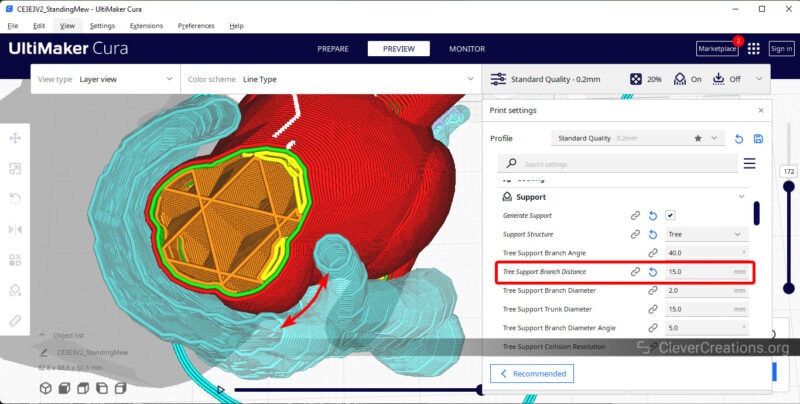
The branch distance setting tells your tree supports how much space to leave between two branches. If the number is low, the branches will be closer together. This makes your overhangs look better and gives your models better support. The problem, though, is that the supports touch your parts in more places and can be more difficult to take off.
In comparison, a greater support distance will place these branches further apart. You’ll have fewer supports that are easier to remove, but the overhangs might need more base layers to prevent quality issues.
Keep a number of 1-2 mm if your model has small parts and lots of small features. You can set it to 2–5 mm for more flat overhangs where bridging can work.
Branch Diameter
The branch diameter setting helps you adjust the size of the tree branches in your supports. A smaller diameter means small branches, while a bigger value leads to a thick and rigid branch structure.
Thicker branches make your supports more stable but also increase material usage and printing time. In the end, it’s about finding the right balance for your specific filament, print settings, and 3D model.
The usual value for Cura, which is 2.0 mm, works fine for most prints. If you want to experiment with it, keep it to no more than 4 or 5 mm. More than that would need extending the base of your tree support.
Support Brim
The Support Brim option is a general setting for Cura tree supports that can be useful in certain situations. It adds more perimeters to the first layer of your tree support structure. It makes supports more stable while printing and makes it easy to take everything off all at once afterward.
Turn on the Support Brim choice and leave the default setting of 4.0 mm. It gives you a good mix between printing time and stability and makes it straightforward to take off the support structure.
How Do You Make Tree Supports Easier to Remove?
Tree Supports are made so that they are easy to remove from your 3D prints during post-processing. After printing, the branch and stems form a single solid structure that comes off at once.
To make removing tree supports even easier, turn on the Support Interface option and adjust the distance between the tree support branches.
Support interfaces print a stable base layer under the overhangs, which will improve the quality of the print. It also keeps the support from sticking to the part and makes it easy to take out the tree support when the printing is done.
The Branch distance, as mentioned above, adjusts the density of the tree support. The supports are more likely to come off in one piece if the density is higher. However, it also increases printing time and material usage. To get this setting right, you’ll need to do a little fine-tuning.
Cura Tree Supports vs. Prusaslicer Organic Supports
PrusaSlicer has recently introduced Organic Support in their PrusaSlicer 2.6 version. These organic supports are similar to Cura tree supports, in that they are made to be easier to remove and designed better than regular support structures.
You can see how different it is from the Cura tree support in the picture above. The PrusaSlicer Organic supports look much more natural and like trees than Cura’s.
For small 3D prints, the difference between Cura tree supports and PrusaSlicer organic supports is negligible. But for larger prints, organic supports are worth looking at. Based on our testing, they use less printing time and less material than the tree supports.
Conclusion
Tree supports are the next evolution of support structures for 3D printing. They use less material, speed up the printing process, and are easier to remove than standard supports.
Cura tree supports work great for models with small features and big overhangs. The overhang quality is better, and the support material leaves little to no marks on the surface of 3D prints.
As with every slicer setting, there is some fine-tuning to do for optimal results. With the recommended Cura tree support settings above, you’ll get going quickly.
Give Cura tree support a shot and let us know how it goes. If you’re having trouble or need help, let us know in the comments below, and we’ll be happy to assist.
